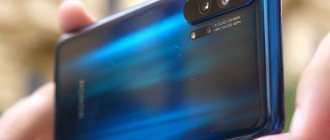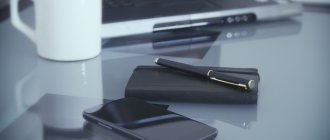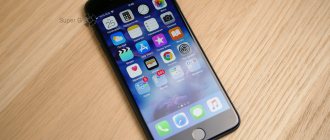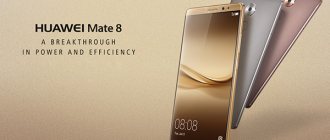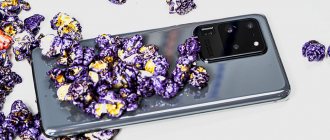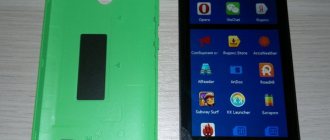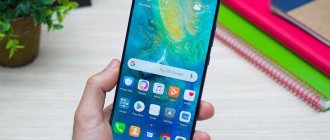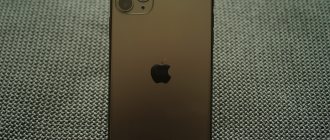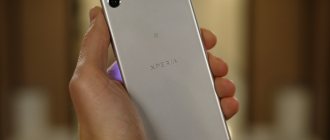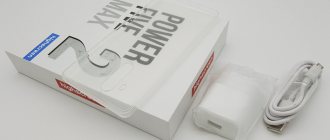There is a joke about Samsung's telephone division: if Samsung releases less than 100 new phone models in a year, it will simply explode with a terrible roar, like the bus in "Speed" (oooh, Sandra...). Developing the joke, experts usually mention that the Koreans manage to do this quite simply - for this they are simultaneously developing five lines, namely regular phones with buttons, regular phones with a touch screen (descendants of Corby), smartphones on Android, smartphones on Windows Phone 7 and what something like this based on Bada’s own OS.
The relatively new flagship of this particular line, the S-8600 Wave 3, was given to us to be torn to pieces. The experience seemed somewhat ambiguous to us, which can be read in more detail below. In the meantime, it’s worth remembering one significant point - phones based on Bada OS are not sold in the “fattest” smartphone market in the world, in the USA. With cheap models this is understandable, but the hero of our review is not there either. The American market is distant and fundamentally different in its structure - cheap subsidized phones, expensive contracts and capricious, snickering subscribers. But we must remember that for many reasons everyone is equal to this market, and this affects the fate of mobile platforms - we also did not forget to write about this [negative] impact.
⇡#About APPEARANCE
It is impossible to find fault with the materials themselves - glass on top of the display, a metal main part and a little high-quality, albeit slippery, plastic in those places where radio transparency needs to be ensured. All this also lies quite comfortably in the hand and has the most suitable weight. But in the end it looks like a patchwork quilt - no solidity.
This patchiness is partly understandable: the body is a slider, the upper metal part of which slides off on rails, freeing up access to the removable (what a blessing!) battery, and after it - to the microSD and SIM slots. It is important to understand that the entire cover cannot be removed, resting against the stoppers and opening access to the slots only to a small extent. This works quite well in the case of microSD, which jumps out of the slot using a spring mechanism, but for SIM it creates certain difficulties - only the very tip of the card protrudes, and it is not easy to pull it out. And the microSIM in adapters does not need to be inserted there at all, because when pulled out, the card itself falls out, and the adapter gets firmly stuck, clinging to inaccessible spring-loaded contacts (and don’t ask how the author knows this).
The screen leaves a special, interesting impression - it seems to be 4 inches diagonal, but you can’t tell by the sensations, it’s more like an iPhone 4 or Nokia Lumia 800. In terms of image quality, it’s a regular SuperAMOLED, similar to its brother in the Galaxy S, only with somewhat “muffled” ” flowers. The screen is covered with a glass panel, but it is not Gorilla Glass. The author does not have the habit of carrying the phone in the same pocket with the keys, but even without this, quite noticeable scratches appeared on the glass in a couple of weeks. By the way, this same glass hides a couple of buttons under it - surprisingly, but, contrary to modern fashion, Wave 3 has buttons for receiving and rejecting calls (aka “back”). There is also one physical front button - the same Home button as on the iPhone or Galaxy, which calls up the manager of running applications with a long press.
Samsung Wave :: Review :: User Interface
Wave greets us with the unusual Bada platform, albeit supplemented by the updated TouchWiz 3.0. So, the main screen, or rather screens - there are up to ten of them in the GT-S8500, although in terms of importance they are all identical and only pressing the end button returns us to the first one. You can add and remove screens in a horizontal position, which is not immediately obvious.
Traditionally, for TouchWiz, the main field of screens is intended for the so-called. widgets and the user can select them from the drop-down list. In this case, the top bar of the screen remains unchanged, containing information about the reception level, current time, battery charge, and also, as they appear, notifications. The two horizontal parallel stripes it contains in the center suggest the notification area, and by pulling the panel down we will open quick access to activating wireless modules, as well as switching to silent mode. Here, as incoming correspondence or missed calls appear, information about them is displayed. An essentially similar notification area is presented in the Android OS and looks very logical.
The lower part of the screen contains access to basic telephone functions - a dialer, messages and an address book. The Wave dialer has a classic structure - 3 columns of 4 virtual keys, although this element is also supplemented with a line of functions at the bottom of call, message and video call.
In the upper part, above the keyboard, we get access to the address book, calls, favorite numbers and the delete key for the last character entered. You can’t deny the convenience of the dialer, and despite its “virtuality,” holding down the “hash” symbol will traditionally allow you to mute the sound.
As for the desktop, it can be covered with wallpaper of the user's choosing. A horizontal picture either has the same tone across all screens, or, if there are objects on it, it is stretched across each one, and as we scroll through it, we gradually move across it.
The Widget inscription in the upper left corner of the screen transparently hints at the possibility of access to editing these desktop elements. Click on it and you will see a pop-up window at the bottom of the screen, which contains still unused elements. By holding and dragging elements, we cover the screens at will with the information we need, or with access icons to functions. It is worth noting that, as before, widgets may not appear neatly on the screen by default, without being tied to the exact display grid. Moving and alignment is possible, but manually, according to your eye.
The lock screen deserves special attention. This initially unremarkable display with the current time and date at the bottom, when calls or messages arrive, turns into a puzzle indicating the number of events. Very clear and convenient. But wait - move the data puzzle piece into an empty cell, and the device will automatically redirect you to the appropriate application. Unlocking the screen, unlike locking with a button, is done by shifting the picture from top to bottom.
Let's go to the main menu. We can’t help but think that it is quite reminiscent of that on the iPhone. Judge for yourself: the lower part also contains links to telephone functions, and then the icons are arranged in a 3x4 matrix (with a 3x5 bottom row). The icons are static with a caption underneath them, and flipping between screens is done in a horizontal plane, like a book. In addition, all functions are contained in the main menu, i.e. there are no submenus with multi-level lists and this is probably a plus for perception, because... We didn’t have to particularly understand the new platform.
An interesting and probably useful menu option is the storage of frequently used applications. Those. Having entered the menu for the first time and worked with it, you will not recognize it later, the layout will be replaced by sequentially launched applications. Thus, we almost always had multimedia and entertainment functions on the first screen. At first, this is somewhat surprising due to the fact that an FM receiver found, for example, on the third screen suddenly appears on the first. The number of screens directly depends on the installed applications, which also creates an association with Apple products.
The interface allows you to sort icons, including the bottom line, which can be convenient. Scrolling through the menu screens, unlike the main ones, is cyclical, and this is a tangible plus with such a variety of applications.
Holding the center key will open the matrix of running applications. Here we can switch between them or close individual or all of them.
Let's dwell in more detail on the main functions of the device and briefly mention the content installed in our test copy, although we will not hide that some applications, alas, did not work.
⇡#About offal and power
The Bada operating system doesn’t need much, so Wave 3’s hardware is similar to smartphones based on Windows Phone 7 - a single-core Qualcomm Scorpion (this is a CPU from Snapdragon assemblies) with a frequency of 1.4 GHz and 512 MB of RAM.
| Specifications Samsung S8600 Wave 3 | |
| Screen | SuperAMOLED, 4.0 inches, 800×480 |
| CPU | Qualcomm Snapdragon MSM8255 1x1.4 GHz |
| Memory | 512 MB RAM + 4 GB ROM + up to 32 GB microSD |
| Wireless network | GPRS/EDGE + HSPA (900/2100 MHz) up to 14.4 Mbit/s; Wi-Fi 802.11n; Bluetooth 3.0; A-GPS |
| Sensors | Accelerometer, digital compass, proximity and light sensors |
| Camera | Main: 5 MP, autofocus, LED flash, video recording up to [email protected] fps Front: VGA |
| Battery | Removable 1500 mAh (3.7 V/5.5 Wh) |
| Dimensions, mm | 125,9×64,2×9,9 |
| Weight, g | 122 |
The only obvious difference is permanent memory, of which, according to official data, 4 GB is preinstalled. According to the “statements” of the operating system, these 4 gigabytes are divided quite intricately: 2.14 GB are given to the “System partition”, 1 GB is for users to be torn apart, and the rest is used in secret projects of the South Korean military and is therefore not shown to the user.
As for performance, the assessments are mostly subjective - the smoothness of scrolling is reminiscent of Android 2.3, applications hardly slow down when launched, but sometimes widgets get stuck, but screen rotation is faster and smoother than on most Android handsets. All that remains is to launch the built-in Dolphin browser and run the SunSpider and BrowserMark tests in it.
And this is where the fun begins. Remember how, in a recent test, the Nokia Lumia 800 (which has the same CPU and amount of RAM) took a serious beating for being two to three times behind the market's flagships in web tests, scoring 31,300 points in BrowserMark and running SunSpider with a score of almost 7,000 ms? So, for Wave 3 everything is much sadder - on average 26590 points in BrowserMark and 10678 ms on SunSpider. For a completely fair comparison, we present the results of another “outdated” model on a single-core processor with 512 MB of RAM - iPhone 4, which with firmware 5.0 scores 50,500 BM points and passes SuSp in 3,602 ms. I want to turn towards Seoul and cry out in despair: “What are you doing, Eagle Yesi As?”
Samsung Wave 525 (S5250) mobile phone review
Despite the fact that high-end smartphones and communicators receive the lion's share of media attention (such as our website), most sales now come from low-cost touchscreen phones such as the Samsung Wave 525, which became the hero of our today's review.
In my opinion, the Wave 525 is the true successor to the insanely popular Samsung Star touch phone at one time. The model index also hints at this (S5230 for Star and S5250 for Wave 525). Indeed, these two devices are very similar - both in appearance and characteristics, but the Wave 525 is built on a more modern platform and offers better functionality.
Before reading this review, I recommend reading the following materials:
- Samsung bada mobile platform: new details
- Preview of Samsung S8500 Wave mobile phone
- Detailed review of Samsung Wave mobile phone (GT-S8500)
- We work with the Samsung Apps application store
Technical characteristics of Samsung Wave 525
- Bands: GPRS/GSM/EDGE 850/900/1800/1900.
- Form factor: keyboardless monoblock.
- Operating system: Samsung bada 1.1 with TouchWiz 3.0 interface.
- Display: 3.2 inches, TFT, 240×400 pixels, 256 thousand colors, touch (capacitive matrix with Multi-Touch support).
- Camera: 3 MP, geotagging, video recording (QVGA, 15 fps).
- Memory: 90 MB + microSD/HC cards.
- Multimedia capabilities: MP3 player, FM receiver, integration with YouTube, Find Music service (analogous to Track ID in Sony Ericsson phones).
- Wireless technologies: Wi-Fi b/g/n, Bluetooth 2.1+EDR.
- Interface connector: microUSB, 3.5 mm headphone output.
- GPS: yes, support A-GPS, support Google Maps.
- Dimensions and weight: 110x55x12 mm, 100 grams.
Video on Samsung Wave 525
View on YouTube
Appearance and design
Samsung Wave 525 is a small, cute all-in-one with a large touch screen. It fits well in the hand and is made of practical materials. In particular, the back cover, like the Samsung Star, has a pattern of raised dots, making scratches on it almost invisible.
The layout of the controls is standard and typical for modern touch phones/smartphones: under the screen there are buttons to accept/end calls, as well as a return key to the main menu; On the left there is a rocker key for controlling the volume, and on the right there is a lock button and a camera button.
At the top are both interface connectors - a 3.5 mm headphone output and Micro-USB for charging and connecting to a computer, and the Micro-USB connector is covered with a sliding plastic curtain.
Screen
Samsung Wave 525 uses the most ordinary TFT screen with a resolution of 240x400 pixels. Its quality is very decent, especially by the standards of this price category. The only drawback is the behavior in bright sunlight - in this case the screen becomes almost completely blind.
The touch surface is made using capacitive technology, multi-touch is supported (but there is nowhere to use it except in the browser). The screen sensitivity is at a good level, at least I did not notice any inconvenience.
Battery, operating time
The Wave 525 uses a 4.44 Wh (1200 mAh) battery, which provides good battery life - 3-4 days with a small number of calls, but active use of network functions (in particular, Push-sync email). Compared to most Android smartphones, which struggle to survive until the evening in this operating mode, this result is pleasantly refreshing.
Menu, interface
Wave 525 runs the bada 1.1 operating system with TouchWiz 3.0 interface. The interface looks exactly the same as in the Wave 723 phone we reviewed earlier.
TouchWiz 3.0 supports up to 10 desktops, on each of which you can place as many widgets as you like. Clicking on the gear button located in the upper left corner of the screen opens the desktop editing mode. bada has a system notification area that opens by touching the status bar. Here you can turn on/off wireless interfaces or quickly switch the phone to silent mode; messages about new events also appear here. When the player or FM receiver is running, playback control buttons appear in the notification area.
The lock screen is quite traditional - after pressing the unlock key, you need to swipe your finger across the entire screen to unlock the phone. If you're listening to music or the radio, a CD icon appears at the top of your lock screen. When you click on it, the player control panel opens.
The main menu has a flat structure (no folders or subfolders). It is divided into several screens, navigation between them is cyclical. The arrangement of icons can be changed arbitrarily. In the settings, you can enable automatic arrangement of icons: in this mode, Wave 525 itself monitors which menu items you use most often and changes their order accordingly.
The device supports limited multitasking: several system applications, one bada application and one Java program can be launched simultaneously. The task manager, as before, is called up by long pressing the menu key.
Samsung Apps
Wave 525 supports work with the online application store Samsung Apps, which you can learn more about in a separate material dedicated to its features.
Multimedia capabilities
Music player. The MP3 player in the Samsung Wave 525 has the already familiar Disk UI interface. The album cover is displayed as large as possible, with playback control buttons located underneath it. To see the rest of the controls, you need to click once on the album cover; the next click on it hides them back.
The music library has the ability to sort music by artists, albums, genres, and so on. You can create your own playlists. The album cover is displayed only if it is included in the MP3 file tags; There are no problems with the Cyrillic alphabet. FM radio. Samsung Wave 525 is equipped with the most common FM receiver with the most common interface.
One of the nice features is the ability to record radio broadcasts; recording is done in MP3 format with a bitrate of 192 kbit/s; the maximum recording duration is limited by the free space in the phone’s memory.
Camera
Wave 525 is equipped with a 3-megapixel camera without autofocus - exactly the same as in the budget Galaxy Mini smartphone, in the review of which you will find a large number of test shots.
Bottom line
In our opinion, Samsung Wave 525 has excellent functionality for its price range - for just 1,500 hryvnia, the buyer gets a phone with support for Wi-Fi, Bluetooth, GPS, an excellent MP3 player and a radio with the ability to record broadcasts, as well as the ability to install additional applications from the store Samsung Apps. Frankly, considering the price, it’s quite difficult to find fault with the phone. Wave 525 is an excellent choice for undemanding users. In addition, decent battery life allows us to recommend it as a second (“talk”) device for users of advanced smartphones. A nice bonus when used in this capacity will be automatic synchronization of the address book between two phones via Exchange ActiveSync. Overall, in my opinion, the Samsung Wave 525 deserves our editorial "We Recommend" award.
5 reasons to buy Samsung Wave 525:
- excellent value for money;
- capacitive touch screen with good sensitivity and Multi-Touch support;
- good (by the standards of touchscreen smartphones) battery life;
- availability of all necessary connection options: Bluetooth, Wi-Fi and even GPS;
- convenient MP3 player and radio.
2 reasons not to buy Samsung Wave 525:
- low screen resolution, limiting the usefulness of “smartphone” functionality;
- inconvenient on-screen keyboard.
⇡#About COMMUNICATION and BATTERY
The main capabilities of Wave 3 in this direction are clear from the tablet; I would only like to note the unexpected possibility for a seemingly “budget” OS of using the phone as an access point with Internet distribution via Wi-Fi (up to 3 clients at the same time). It’s nice that in the settings panel of this option there is a window showing the amount of traffic passed through the access point.
As for the quality of voice communication, with such a dense, heavy metal case, the plastic ends of the case (somewhat reminiscent of those on the iPad 3G) absolutely justified themselves - the voice quality is as good as the network usually allows.
The battery life also greatly depends on this factor. Standard hardware and a standard battery give the same standard results - a day of active use. The only “advantage” of Bada in this sense is that the operating system somewhat slows down an overly active user, not causing the desire to use Wave 3 as often as any decent smartphone on Android, iOS or WP7, which extends autonomous navigation by another half a day.
⇡#About SOFT
Why is this happening? The answer lies in the operating system that runs the Samsung Wave 3 - Bada 2.0. As already mentioned, it seems to “run” quite quickly and sometimes pleasantly surprises you from around the corner (distributing the Internet via Wi-Fi), but at the same time, many things about it are unpleasantly surprising. For example, the design is terribly canary and... well, let's say, Asian. Periodic failures in menu logic - for example, when the “back” button in one place looks completely different from the rest.
At the same time, the Bada interface leaves a “solid” feeling, mainly with Android 2.x and iOS. This is beneficial for Samsung - after playing with Bada, the user will (possibly) switch to Galaxy phones and find a fairly familiar interface there, with the same notifications in the drop-down menu and the same several screens with widgets and very similar icons. Thus, the tactical goal is an “affordable” imitation of Android from Samsung, which is a bit reminiscent of student experiments with Mac OS X skins for Windows XP.
At some point, another user may be deceived by the similarity and want too much from the system. It’ll go into Samsung Apps (let’s forget for a moment about the possibility of launching Java games), and then... It’s a hell of a ride, to be honest. There are some useful programs like unit converters (10 rubles, payment with premium SMS), but in general it’s poor. The usual Google+, Opera, Evernote or Skype are not available. Social networks are available only through Samsung’s Social Hub, and they haven’t heard anything about VKontakte (however, there are several home-made applications for VK). Themes are mixed together with applications - good for corporate reports, bad for users. And most importantly, the level of many applications, even quite popular ones, is depressingly low.
And the explanation is very simple - as a rule, truly high-quality projects are financially motivated in advance; they are rarely created “for oneself.” The US almost always dominates software revenue, and in Bada's case the US is excluded from the process. To put it very crudely, if the mobile OS is not in the USA, then consider it to be non-existent for the progressive public, and developers will not be excited by its popularity in France, China and Russia.
Smartphone Samsung Wave II GT-S8530 Black - Specifications
With a rich multimedia experience, Social Hub and an enhanced interface, the new Samsung Wave II smartphone redefines what a smart device can do. The model is equipped with an ultra-clear 3.7-inch LCD display. Optimizing the user experience is facilitated by t9 Trace technology, improved Internet navigation and a powerful 1 GHz processor. In addition, Wave II has support for HD video and access to the Samsung Apps service, which allows you to personalize your smartphone by downloading any applications you like. Contacts of the phone book, social networks, chats and email are collected in a single center Social Hub: when everything is at hand, communication is much more pleasant! Ultra-clear 3.7" LCD display Bigger is better. Wave II features a 3.7-inch Super Clear LCD display that makes browsing, video, and photography on the go much more enjoyable. In addition, compared to conventional TFT LCD screens, the display is much brighter and has less glare.
Faster typing with T9 Trace Wave II features t9 Trace technology, which allows you to enter data by sliding your finger from one letter to another without pressing individual buttons. With t9 Trace, typing speeds up significantly.
High Performance (1GHz Processor) Wave II is equipped with a 1GHz processor that provides excellent speed and performance. This will allow you to work on the Internet as comfortably as possible, without freezing, even when downloading several files at the same time.
Samsung Apps application store: variety and functionality Thanks to Samsung Apps, you can constantly add new, most interesting and diverse applications and widgets that suit you. Samsung Apps lets you download games, e-books, news and social media apps, and more. All programs are fully optimized to work with Samsung Wave. Make your smartphone even smarter with apps for every occasion.
Wave II's extensive range of multimedia features will keep you entertained on the road. The new product supports a wide range of multimedia functions; moreover, using the Samsung Apps service, you can easily find and download many e-books, games and other useful and interesting applications to your smartphone. HD video player (720p.) will provide full compatibility with video files of various formats (DivX, Xvid, MPEG4, real, MKV, ASF and WMV), high quality HD games and has such advanced features as mosaic search and subtitle support. The ability to record HD video using a 5 megapixel camera will allow you to capture unfolding events in every detail. And with the help of a pre-installed video and image editor, you can easily edit and create your own videos. For storing data beyond 2 GB. Wave II internal memory supports microSD memory cards up to 32 GB.
Social Hub Social Hub In Wave II, phone book entries, instant messaging services, email and social networks are consolidated on one page. To organize and view contacts, there are four ways to present information - “Info”, “History”, “Events” and “Media”. Make your communication simpler and more convenient.
⇡#About YANDEX
The local partnership between Samsung and Yandex improves the situation a little. Samsung representatives even threatened to “make Bada for Yandex what Android is for Google,” but developments suggest that Yandex has slightly different plans.
In the meantime, the buyer of Wave 3, when turning on the smartphone for the first time, receives four pre-installed applications (“Maps”, “Metro”, “Mail” and for some reason “Market”), as well as a large convenient widget on the first screen with weather forecasts, traffic jams, and exchange rates and search. We must admit that the additions from Yandex were of great benefit to Bada 2.0, we look forward to the new ones.
Firmware
Today it is possible to install two operating systems on the Samsung Wave GT-S8500. This is BadaOS and a more versatile and functional Android. Official firmware methods, unfortunately, do not work due to the manufacturer ceasing to release updates,
but there are tools available that make installing one of the systems quite easy. It is recommended to go step by step, following the instructions for installing the software, starting with the first method.
Method 1: Firmware BadaOS 2.0.1
Samsung Wave GT-S8500 should officially run BadaOS. To restore the device in case of loss of functionality, update the software, and also prepare the smartphone for further installation of modified OS, follow the steps below, which involve using the MultiLoader application as a manipulation tool.
Download MultiLoader flasher for Samsung Wave GT-S8500
- Download the BadaOS package from the link below and unpack the archive with files into a separate directory.
- Unpack the file with the flash driver and open MultiLoader_V5.67 by double-clicking on the application icon in the resulting directory.
- In the Multiloader window, check the “Boot Change” and “Full Download” checkboxes. Also, make sure that “LSI” is selected in the hardware platform selection field.
- Click “Boot” and in the “Browse Folder” window that opens, locate the folder containing the firmware.
- The next step is adding files with software data to the flasher. To do this, you need to click the buttons for adding individual components one by one and indicate to the program the location of the corresponding files in the Explorer window.
Everything is filled out according to the table:
After selecting a component, click “Open”.
- “Amms” button - amms.bin ;
"Apps";
- "Rsrc1";
- "Rsrc2";
- "Factory FS";
- "FOTA".
- The fields “Tune”, “ETC”, “PFS” are left blank. Before you start loading files into the device’s memory, MultiLoader should look like this:
- Put the Samsung GT-S8500 into system software installation mode. This is done by pressing three hardware buttons simultaneously on the switched off smartphone: “Volume Down”, “Unlock”, “Power On”.
- The keys must be held until the screen displays: “Download mode”.
- Connect the Wave GT-S8500 to the USB port of your computer. The smartphone will be detected by the system, as evidenced by the appearance of the COM port designation at the bottom of the Multiloader window and the display of o in the field next to it.
When this does not happen and the device is not detected, click the “Port Search” button.
- Everything is ready to start flashing the BadaOS firmware. Click “Download”.
- Wait for the files to be written to the device’s memory. The log field on the left side of the MultiLoader window, as well as the filling progress indicator of file transfer, allows you to monitor the progress of the process.
- You will have to wait about 10 minutes, after which the device will automatically reboot into Bada 2.0.1.
Additionally: If you have a “battered” smartphone that cannot be switched to software download mode due to low battery power, you need to remove and replace the battery, and then connect the charger while holding down the “On-hook” key on the device. A battery image will appear on the screen and the Wave GT-S8500 will begin charging.
Method 2: Bada+Android
If the functionality of the Bada OS is not enough to perform modern tasks, you can take advantage of the option of installing the Android operating system in the Wave GT-S8500. Enthusiasts ported Android to the smartphone in question and created a solution that allows the device to be used in dual boot mode. Android is loaded from the memory card, but Bada 2.0 remains an untouched system and is launched when necessary.
Step 1: Preparing the Memory Card
Before proceeding with the Android installation, prepare a memory card using the capabilities of the MiniTool Partition Wizard application. This tool will allow you to create partitions necessary for the system to function.
⇡#About ENTERTAINMENT
We decided to highlight this item because the phone’s firmware has as many as 8 applications of this type. These are “Music” (carousel scrolling of covers works in horizontal mode), “Video” (MP4, DivX/XviD, WMV and 3GP are supported), “Gallery”, “Radio”, “Voice Recorder” (quite suitable), “Voice Control” (Russian is not supported), Music Store, YouTube and AllShare.
The Wave 3 multimedia component has a couple of differences. Firstly, the sound chip on this phone is something called the Digital Natural Sound Engine. We don’t undertake to evaluate the improvement in sound quality, but the volume has definitely increased; it will not be difficult to sound an average room with a sufficient initial volume of the file for Wave 3.
Secondly, it’s not for nothing that the phone was released by Samsung - through the AllShare application it allows you to play video, audio and photo files available on the device on compatible TVs, provided that they are connected to the same network - essentially, a more human and easily manageable version of DLNA .
⇡#About the CAMERA
The camera is the most common 5-megapixel camera, which we suggest you see by looking at the example photos in the gallery. From an ergonomic point of view, the complaints are the same - the lack of a dedicated hardware start/shutter button and a hidden settings menu that needs to be called up by a separate press.
⇡#About OUTPUT
As for the Bada OS itself and the accompanying ecosystem, they currently represent a kind of huge loaf of bread that an inexperienced baker put in the oven, but periodically pulls out so that everyone can break off a piece and evaluate the degree of baking. There is nothing wrong with this, everyone has to start somewhere, but there are three problems: 1) the loaf still won’t bake; 2) taking samples for innocent consumers costs very real money; 3) excellent fresh bread is already being sold around at reasonable prices.
However, approaching the assessment of Wave 3 less critically, we can draw the following conclusion: if the display, design and (possibly) sound are more important to you than the richness of the choice of applications, then you can forget about the Wave 3 being a smartphone and pay 13 thousand. But you will never understand the “trick” of owning a smartphone and the endless expandability of its functionality through applications. Which will be at least regrettable.
